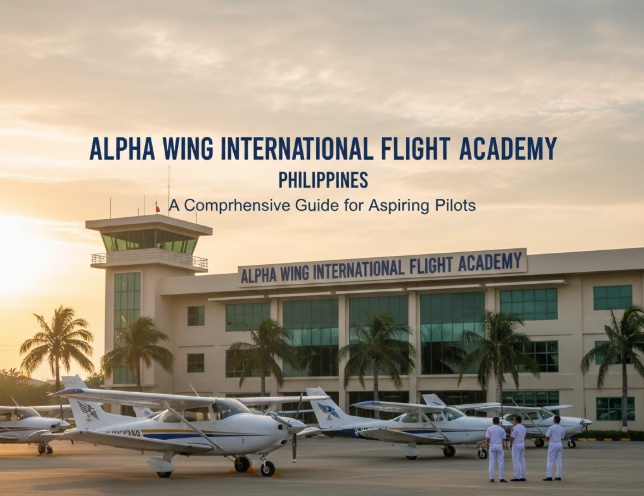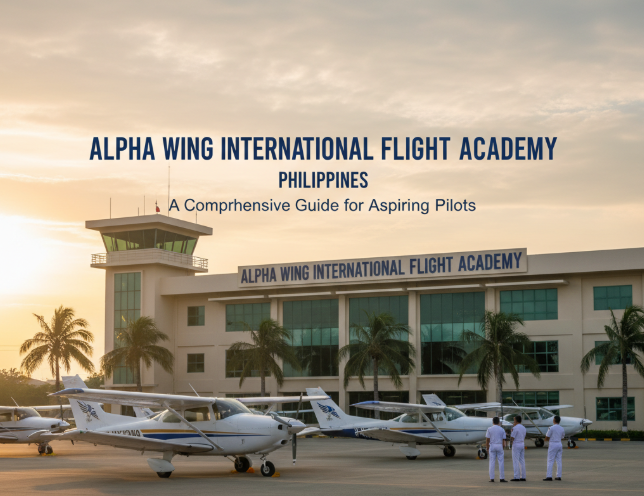
Aviation has become one of the most exciting career paths for many individuals worldwide, and the Philippines is no exception. With its growing aviation industry, the country has seen a surge in the demand for trained pilots, flight instructors, and aviation professionals. Whether you’re aspiring to become an airline pilot or a flight instructor, the Philippines offers a wealth of opportunities through its international flight academies and pilot training programs. This blog will explore the world of International Flight Academies in the Philippines, highlighting their importance, history, current roles, eligibility, training requirements, technology, challenges, and career opportunities.
Introduction to International Flight Academy in Philippines
What is an International Flight Academy?
An International Flight Academy is a specialized institution that provides comprehensive training for individuals pursuing careers in aviation. These academies offer various flight training programs aimed at preparing students for commercial pilot licenses (CPL), private pilot licenses (PPL), flight instructor licenses, and other aviation certifications. International flight academies in the Philippines cater to both local and international students, providing them with the necessary skills to fly a range of aircraft safely and efficiently.
These academies typically feature a combination of classroom education, flight training, and state-of-the-art simulation technology. The programs are designed to meet international standards set by aviation regulatory bodies like the International Civil Aviation Organization (ICAO) and the Civil Aviation Authority of the Philippines (CAAP).
Importance of Aviation in the Philippines
Aviation plays a vital role in the economic and social development of the Philippines. As an archipelago with over 7,000 islands, air travel is crucial for connecting various regions of the country and facilitating trade, tourism, and emergency services. The Philippines is also strategically located in Southeast Asia, making it an important hub for international flights.
Key Contributions of Aviation in the Philippines:
- Economic Growth: Aviation supports millions of jobs, both directly and indirectly. This includes pilots, air traffic controllers, ground staff, and airline personnel.
- Tourism: The Philippines is known for its beautiful beaches, tropical climate, and vibrant culture, attracting millions of international tourists annually.
- Connectivity: With its geographical makeup, aviation is the primary means of transport for inter-island travel and connecting the Philippines to global destinations.
History and Development of Aviation in the Philippines
The history of aviation in the Philippines dates back to the early 1900s. Since then, the industry has evolved significantly, contributing to the modernization of both civil and military aviation sectors.
Early Aviation History
- 1920s: The first recorded flight in the Philippines was made by a French pilot who flew a hydroplane over Manila Bay. This marked the beginning of aviation in the country.
- 1930s: The establishment of the Philippine Air Lines (PAL) in 1941 helped establish the Philippines as a key player in the regional aviation sector.
Milestones in Philippine Aviation
- 1960s: PAL became one of the first airlines in Asia to operate jet-powered aircraft.
- 1990s: With the expansion of low-cost carriers, domestic travel became more affordable, contributing to the growth of the aviation sector.
- 2000s and Beyond: The Philippines has embraced modern technologies like flight simulators and digital cockpits, making training more effective and accessible.
Current Role of International Flight Academy in Philippines
How International Flight Academies Operate Today
Today, International Flight Academies in the Philippines are essential components of the aviation ecosystem. These institutions play a critical role in training the next generation of pilots, aviation engineers, and air traffic controllers. They offer world-class training using the latest flight simulators, real aircraft, and industry-standard curricula.
In addition to producing skilled pilots, these academies also contribute to the civil aviation industry, ensuring a steady supply of qualified professionals for airlines and other aviation-related services. As the Philippines’ aviation industry continues to grow, these academies have adapted to meet the needs of both local and international students, ensuring that the next generation of aviators is well-equipped to handle modern aviation challenges.
Eligibility, Training, and Skills Required
Basic Qualifications
To join an International Flight Academy in the Philippines, students typically need to meet certain educational and physical qualifications. These qualifications ensure that students are prepared for the rigorous demands of flight training.
- Education: Most flight academies require applicants to have a high school diploma, although a bachelor’s degree is preferred for certain programs.
- Health: Applicants must undergo a medical examination to ensure they meet the physical standards required for flying.
- Age: The minimum age for beginning flight training is typically 17 years, but some academies may have age restrictions based on the type of training program.
Technical and Soft Skills
While academic qualifications are essential, students must also develop the following skills:
- Technical Skills: Knowledge of navigation, meteorology, aerodynamics, and aircraft systems.
- Soft Skills: Leadership, decision-making, teamwork, and communication skills are also vital for aspiring pilots.
Institutes, Academies, and Training Centers in Philippines
5–7 Major Flight Academies in the Philippines
The Philippines is home to several reputable aviation schools and training centers. Some of the most well-known include:
- Philippine State College of Aeronautics (PhilSCA): A government-run institution offering a wide range of aviation-related courses, including pilot training, air traffic control, and aircraft maintenance.
- AeroPhil Aviation School: Known for its pilot training programs, AeroPhil offers a variety of flight courses, including private and commercial pilot licenses.
- Flying School of Aviation (FSA): FSA provides comprehensive flight training programs, from private pilot licenses to flight instructor certifications.
- Airworks Aviation Academy: Specializing in aircraft maintenance and pilot training, Airworks offers a variety of aviation programs aimed at aspiring professionals.
- Batangas State University – College of Aeronautical Engineering: A prestigious institution that offers bachelor’s degree programs in aeronautical engineering and flight training.
Government Initiatives and Regulatory Authorities
The Civil Aviation Authority of the Philippines (CAAP) plays a pivotal role in regulating the aviation industry and ensuring safety standards are met. Government programs and initiatives also promote the growth of the aviation sector and provide financial support for aviation-related training and infrastructure.
Technology and Innovation in Aviation Training
As aviation continues to evolve, so does the technology used in training pilots and aviation professionals. International flight academies in the Philippines are adopting advanced technologies to enhance the learning experience.
- Flight Simulators: Modern flight simulators allow students to practice flying in a controlled environment, providing realistic training scenarios.
- AI in Cockpit Training: Artificial intelligence (AI) is now being used in aviation training to help students understand flight patterns, automate cockpit processes, and enhance safety measures.
- Spacecraft Navigation: With advancements in space travel, some flight schools are introducing space travel training, preparing students for the future of aviation and space tourism.
Challenges Faced in Pilot Training in Philippines
While the aviation industry in the Philippines is growing rapidly, there are still challenges that aspiring pilots and flight academies face.
Infrastructure Gaps
Some flight academies struggle with outdated training facilities and a lack of modern aircraft, limiting the quality of education provided.
Cost of Training
Flight training can be expensive, especially for international students, which makes accessibility a concern for many aspiring pilots.
Regulatory Hurdles
The complex regulatory requirements for obtaining flight certifications can be challenging, especially for international students seeking to train in the Philippines.
Brain Drain
A significant challenge for the Philippines is the migration of trained pilots to other countries for higher-paying job opportunities, leading to a shortage of qualified pilots domestically.
Future of International Flight Academy in Philippines
The future of International Flight Academies in the Philippines looks promising, with several emerging trends shaping the aviation landscape.
- Space Tourism: As space tourism grows, there will be more opportunities for training in spacecraft navigation and space travel.
- Private Aviation: The rise of private jets and small aircraft means that flight schools will expand their training programs to meet the needs of private aviators.
- AI and Automation: Continued integration of AI into training programs will revolutionize the aviation industry, making training more efficient and effective.
Career Path & Opportunities
Step-by-Step Path to Becoming a Pilot
- Education: Complete basic education requirements (high school diploma or degree).
- Pilot Training: Enroll in a flight school or academy and earn the appropriate pilot certifications.
- Advanced Training: Pursue specialized training for commercial pilots or flight instructors.
- Employment: Seek employment with airlines, charter services, or private aviation companies.
Salary Expectations and Global Opportunities
The average salary for pilots in the Philippines varies, but generally, commercial pilots can expect to earn competitive wages. There are also opportunities to work abroad, particularly in countries with growing aviation markets like the Middle East, the United States, and Southeast Asia.
FAQs (10–12 Q&A)
- How much does pilot training cost in the Philippines?
- The cost varies depending on the program, but a typical private pilot course can cost anywhere from PHP 500,000 to PHP 1,000,000.
- Which is the best aviation institute in the Philippines?
- This depends on your specific needs, but some of the top institutions include PhilSCA, Flying School of Aviation, and AeroPhil.
- What qualifications are needed for pilot training in the Philippines?
- Basic educational qualifications (high school or a bachelor’s degree) and passing a medical exam are required to begin training.
- Is international flight training available in the Philippines?
- Yes, the Philippines is home to several international flight schools that accept students from around the world.
Conclusion / Final Thoughts
The aviation industry in the Philippines offers exciting opportunities for aspiring pilots. International flight academies in the country provide world-class training and prepare students for a successful career in aviation. With a growing demand for pilots and aviation professionals, there has never been a better time to explore this field. For those eager to take to the skies, the Philippines provides an ideal environment for training and launching an aviation career.
